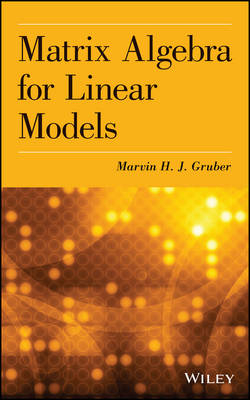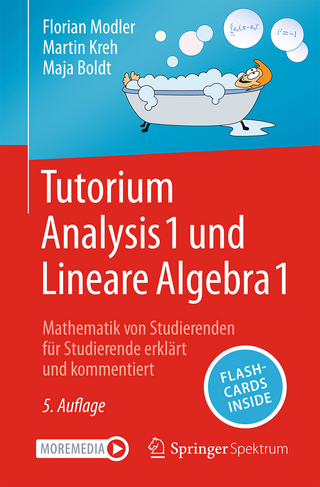
Matrix Algebra for Linear Models
John Wiley & Sons Inc (Verlag)
978-1-118-59255-7 (ISBN)
A self-contained introduction to matrix analysis theory and applications in the field of statistics
Comprehensive in scope, Matrix Algebra for Linear Models offers a succinct summary of matrix theory and its related applications to statistics, especially linear models. The book provides a unified presentation of the mathematical properties and statistical applications of matrices in order to define and manipulate data.
Written for theoretical and applied statisticians, the book utilizes multiple numerical examples to illustrate key ideas, methods, and techniques crucial to understanding matrix algebra’s application in linear models. Matrix Algebra for Linear Models expertly balances concepts and methods allowing for a side-by-side presentation of matrix theory and its linear model applications. Including concise summaries on each topic, the book also features:
Methods of deriving results from the properties of eigenvalues and the singular value decomposition
Solutions to matrix optimization problems for obtaining more efficient biased estimators for parameters in linear regression models
A section on the generalized singular value decomposition
Multiple chapter exercises with selected answers to enhance understanding of the presented material
Matrix Algebra for Linear Models is an ideal textbook for advanced undergraduate and graduate-level courses on statistics, matrices, and linear algebra. The book is also an excellent reference for statisticians, engineers, economists, and readers interested in the linear statistical model.
MARVIN H. J. GRUBER, PHD, is Professor Emeritus in the School of Mathematical Sciences at Rochester Institute of Technology. He has authored several books and journal articles in his areas of research interest, which include improving the efficiency of regression estimators. Dr. Gruber is a member of the American Mathematical Society and the American Statistical Association.
Preface xiii
Acknowledgments xv
Part I Basic Ideas about Matrices and Systems of Linear Equations 1
Section 1 What Matrices are and Some Basic Operations with Them 3
1.1 Introduction 3
1.2 What are Matrices and why are they Interesting to a Statistician? 3
1.3 Matrix Notation Addition and Multiplication 6
1.4 Summary 10
Exercises 10
Section 2 Determinants and Solving a System of Equations 14
2.1 Introduction 14
2.2 Definition of and Formulae for Expanding Determinants 14
2.3 Some Computational Tricks for the Evaluation of Determinants 16
2.4 Solution to Linear Equations Using Determinants 18
2.5 Gauss Elimination 22
2.6 Summary 27
Exercises 27
Section 3 The Inverse of a Matrix 30
3.1 Introduction 30
3.2 The Adjoint Method of Finding the Inverse of a Matrix 30
3.3 Using Elementary Row Operations 31
3.4 Using the Matrix Inverse to Solve a System of Equations 33
3.5 Partitioned Matrices and Their Inverses 34
3.6 Finding the Least Square Estimator 38
3.7 Summary 44
Exercises 44
Section 4 Special Matrices and Facts about Matrices that will be used in the Sequel 47
4.1 Introduction 47
4.2 Matrices of the Form aIn + bJn 47
4.3 Orthogonal Matrices 49
4.4 Direct Product of Matrices 52
4.5 An Important Property of Determinants 53
4.6 The Trace of a Matrix 56
4.7 Matrix Differentiation 57
4.8 The Least Square Estimator Again 62
4.9 Summary 62
Exercises 63
Section 5 Vector Spaces 66
5.1 Introduction 66
5.2 What is a Vector Space? 66
5.3 The Dimension of a Vector Space 68
5.4 Inner Product Spaces 70
5.5 Linear Transformations 73
5.6 Summary 76
Exercises 76
Section 6 The Rank of a Matrix and Solutions to Systems of Equations 79
6.1 Introduction 79
6.2 The Rank of a Matrix 79
6.3 Solving Systems of Equations with Coefficient Matrix of Less than Full Rank 84
6.4 Summary 87
Exercises 87
Part II Eigenvalues the Singular Value Decomposition and Principal Components 91
Section 7 Finding the Eigenvalues of a Matrix 93
7.1 Introduction 93
7.2 Eigenvalues and Eigenvectors of a Matrix 93
7.3 Nonnegative Definite Matrices 101
7.4 Summary 104
Exercises 105
Section 8 The Eigenvalues and Eigenvectors of Special Matrices 108
8.1 Introduction 108
8.2 Orthogonal Nonsingular and Idempotent Matrices 109
8.3 The Cayley–Hamilton Theorem 112
8.4 The Relationship between the Trace the Determinant and the Eigenvalues of a Matrix 114
8.5 The Eigenvalues and Eigenvectors of the Kronecker Product of Two Matrices 116
8.6 The Eigenvalues and the Eigenvectors of a Matrix of the Form aI + bJ 117
8.7 The Loewner Ordering 119
8.8 Summary 121
Exercises 122
Section 9 The Singular Value Decomposition (SVD) 124
9.1 Introduction 124
9.2 The Existence of the SVD 125
9.3 Uses and Examples of the SVD 127
9.4 Summary 134
Exercises 134
Section 10 Applications of the Singular Value Decomposition 137
10.1 Introduction 137
10.2 Reparameterization of a Non-full-Rank Model to a Full-Rank Model 137
10.3 Principal Components 141
10.4 The Multicollinearity Problem 143
10.5 Summary 144
Exercises 145
Section 11 Relative Eigenvalues and Generalizations of the Singular Value Decomposition 146
11.1 Introduction 146
11.2 Relative Eigenvalues and Eigenvectors 146
11.3 Generalizations of the Singular Value Decomposition:Overview 151
11.4 The First Generalization 152
11.5 The Second Generalization 157
11.6 Summary 160
Exercises 160
Part III Generalized Inverses 163
Section 12 Basic Ideas about Generalized Inverses 165
12.1 Introduction 165
12.2 What is a Generalized Inverse and how is One Obtained? 165
12.3 The Moore–Penrose Inverse 170
12.4 Summary 173
Exercises 173
Section 13 Characterizations of Generalized Inverses Using the Singular Value Decomposition 175
13.1 Introduction 175
13.2 Characterization of the Moore–Penrose Inverse 175
13.3 Generalized Inverses in Terms of the Moore–Penrose Inverse 177
13.4 Summary 185
Exercises 186
Section 14 Least Square and Minimum Norm Generalized Inverses 188
14.1 Introduction 188
14.2 Minimum Norm Generalized Inverses 189
14.3 Least Square Generalized Inverses 193
14.4 An Extension of Theorem 7.3 to Positive-Semi-definite Matrices 196
14.5 Summary 197
Exercises 197
Section 15 More Representations of Generalized Inverses 200
15.1 Introduction 200
15.2 Another Characterization of the Moore–Penrose Inverse 200
15.3 Still another Representation of the Generalized Inverse 204
15.4 The Generalized Inverse of a Partitioned Matrix 207
15.5 Summary 211
Exercises 211
Section 16 Least Square Estimators for Less than Full-Rank Models 213
16.1 Introduction 213
16.2 Some Preliminaries 213
16.3 Obtaining the LS Estimator 214
16.4 Summary 221
Exercises 221
Part IV Quadratic Forms and the Analysis of Variance 223
Section 17 Quadratic Forms and their Probability Distributions 225
17.1 Introduction 225
17.2 Examples of Quadratic Forms 225
17.3 The Chi-Square Distribution 228
17.4 When does the Quadratic Form of a Random Variable have a Chi-Square Distribution? 230
17.5 When are Two Quadratic Forms with the Chi-Square Distribution Independent? 231
17.6 Summary 234
Exercises 235
Section 18 Analysis of Variance: Regression Models and the One- and Two-Way Classification 237
18.1 Introduction 237
18.2 The Full-Rank General Linear Regression Model 237
18.3 Analysis of Variance: One-Way Classification 241
18.4 Analysis of Variance: Two-Way Classification 244
18.5 Summary 249
Exercises 249
Section 19 More ANOVA 253
19.1 Introduction 253
19.2 The Two-Way Classification with Interaction 254
19.3 The Two-Way Classification with One Factor Nested 258
19.4 Summary 262
Exercises 262
Section 20 The General Linear Hypothesis 264
20.1 Introduction 264
20.2 The Full-Rank Case 264
20.3 The Non-full-Rank Case 267
20.4 Contrasts 270
20.5 Summary 273
Exercises 273
Part V Matrix Optimization Problems 275
Section 21 Unconstrained Optimization Problems 277
21.1 Introduction 277
21.2 Unconstrained Optimization Problems 277
21.3 The Least Square Estimator Again 281
21.4 Summary 283
Exercises 283
Section 22 Constrained Minimization Problems with Linear Constraints 287
22.1 Introduction 287
22.2 An Overview of Lagrange Multipliers 287
22.3 Minimizing a Second-Degree Form with Respect to a Linear Constraint 293
22.4 The Constrained Least Square Estimator 295
22.5 Canonical Correlation 299
22.6 Summary 302
Exercises 302
Section 23 The Gauss–Markov Theorem 304
23.1 Introduction 304
23.2 The Gauss–Markov Theorem and the Least Square Estimator 304
23.3 The Modified Gauss–Markov Theorem and the Linear Bayes Estimator 306
23.4 Summary 311
Exercises 311
Section 24 Ridge Regression-Type Estimators 314
24.1 Introduction 314
24.2 Minimizing a Second-Degree Form with Respect to a Quadratic Constraint 314
24.3 The Generalized Ridge Regression Estimators 315
24.4 The Mean Square Error of the Generalized Ridge Estimator without Averaging over the Prior Distribution 317
24.5 The Mean Square Error Averaging over the Prior Distribution 321
24.6 Summary 321
Exercises 321
Answers to Selected Exercises 324
References 366
Index 368
| Erscheint lt. Verlag | 11.2.2014 |
|---|---|
| Verlagsort | New York |
| Sprache | englisch |
| Maße | 163 x 241 mm |
| Gewicht | 644 g |
| Themenwelt | Mathematik / Informatik ► Mathematik ► Algebra |
| ISBN-10 | 1-118-59255-7 / 1118592557 |
| ISBN-13 | 978-1-118-59255-7 / 9781118592557 |
| Zustand | Neuware |
| Informationen gemäß Produktsicherheitsverordnung (GPSR) | |
| Haben Sie eine Frage zum Produkt? |
aus dem Bereich


